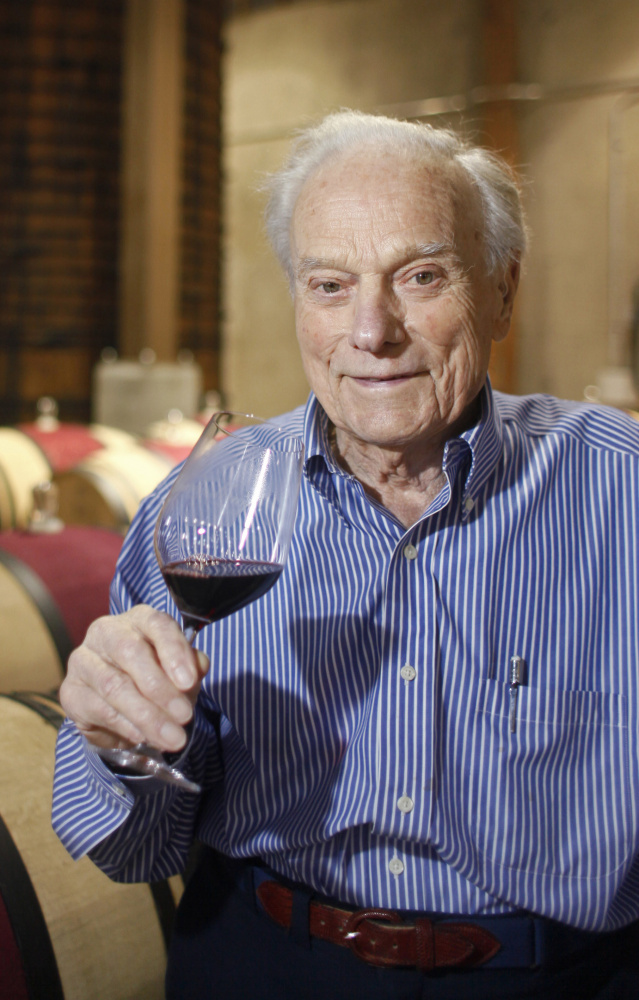SAN FRANCISCO — As a boy, Peter Mondavi got his start in the California wine business by nailing boxes for his father’s grape-shipping business.
In the decades that followed, he became a Napa Valley innovator as he battled his more famous brother Robert Mondavi for control of his family’s Charles Krug Winery.
He still had his hand in the business when he died Saturday at 101. He credited his stamina to good genes, hard work, pasta Bolognese – and a daily glass of cabernet sauvignon.
Mondavi died at his home in St. Helena, California, said Wendy Lane Stevens, a member of the C. Mondavi and Family board of directors.
Peter Mondavi invested a lifetime in building, growing and protecting his family’s business.
A statement released by his family said Mondavi was asked late in life about his proudest accomplishment and said, “Never losing control of our family winery. If I could, I would tell my father: I did the best I could during the difficult years. I was determined and we held on.”
Mondavi began his career at a time when the Napa Valley was known chiefly for cheap wine and witnessed it grow into one of the world’s premiere wine regions.
He played a part in that rise, pioneering a number of improvements to California winemaking, including the use of cold fermentation for white wines and sterile filtration.
Charles Krug has been in the hands of the Mondavi family since 1943, when it was purchased by Mondavi’s parents, Cesare and Rosa.
Peter and Robert ran the winery together after Cesare’s death in 1959 but were unable to agree on management styles and split, with Robert founding the Robert Mondavi Winery in 1966.
Later, the brothers reconciled and in 2005 celebrated their reunion by making a special blend of wine together.
Peter Mondavi’s sons now lead the family business. Marc Mondavi heads the 1.4 million-case CK Mondavi Vineyards division, producer of a popular line of affordable wines, and Peter Jr. leads Charles Krug, producer of premium Napa Valley wines.
Born Nov. 8, 1914, the youngest of four children, Peter Mondavi moved with his family to Lodi, California, in 1922 so his father could start a business shipping grapes to winemakers back in Minnesota during Prohibition. Peter Mondovi’s first job was to assemble and pack 30-pound boxes of grapes.
He went on to earn a degree in economics from Stanford University in 1937 and was drawn to the wine business, studying enology at the University of California, Berkeley.
World War II interrupted his career and Mondavi served in the military, returning stateside in 1946.
In his studies, he had researched the effects of cold fermentation on white and rose wines, which then were being fermented at higher temperatures. The process meant they lost their fruity character through oxidation. He applied what he learned at the winery to make fresher whites.
Charles Krug also was the first Napa Valley winery to import French oak barrels to use in aging wine, and in 1963 was among the first to vintage-date varietal wines.
Determined to keep the winery family-owned despite corporate buyouts happening throughout the valley, Peter Mondavi worked to preserve the family holdings, investing $24 million over a nine-year period to replant most of the vineyards and farm them sustainably. Today, the Peter Mondavi family owns 850 acres of prime vineyards in the Napa Valley.
(The Robert Mondavi Winery was sold to Constellation Brands in 2004.)
Peter Mondavi also took steps to preserve the history of Charles Krug, overseeing the restoration of two landmark buildings – the 1872 Redwood Cellar and the 1881 Carriage House – that are now registered on the National Registry of Historic Places and considered California historical landmarks. His efforts were recognized with the Governor’s Historic Preservation Award in 2010.
After returning from World War II, Mondavi married Blanche Hurtzig, who died in 2010. The couple had three children, Marc, Peter Jr. and a daughter, Siena. They had nine grandchildren and two great-grandchildren.
Send questions/comments to the editors.



Success. Please wait for the page to reload. If the page does not reload within 5 seconds, please refresh the page.
Enter your email and password to access comments.
Hi, to comment on stories you must . This profile is in addition to your subscription and website login.
Already have a commenting profile? .
Invalid username/password.
Please check your email to confirm and complete your registration.
Only subscribers are eligible to post comments. Please subscribe or login first for digital access. Here’s why.
Use the form below to reset your password. When you've submitted your account email, we will send an email with a reset code.